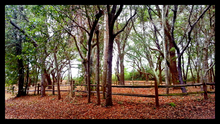Battle of Secessionville
| Battle of Secessionville | |||||||
|---|---|---|---|---|---|---|---|
| Part of the American Civil War | |||||||
 Secessionville Battlefield |
|||||||
|
|||||||
| Belligerents | |||||||
|
|
|
||||||
| Commanders and leaders | |||||||
| Henry Benham |
Nathan G. Evans Thomas G. Lamar |
||||||
| Units involved | |||||||
| North District, Department of the South | 2nd Military District of South Carolina Tower Battery/Fort Lamar Garrison |
||||||
| Strength | |||||||
| 6,600 | 2,000 | ||||||
| Casualties and losses | |||||||
| 685 | 204 | ||||||
The Battle of Secessionville (or the First Battle of James Island) was fought on June 16, 1862, during the American Civil War. Confederate forces defeated the Union's only attempt to capture Charleston, South Carolina, by land.
In early June 1862, Union Maj. Gen. David Hunter transported the Union divisions of Brig. Gens. Horatio G. Wright and Isaac I. Stevens, under the immediate direction of Brig. Gen. Henry Benham, to James Island, where they entrenched at Grimball's Landing near the southern flank of the Confederate defenses. Benham landed 6,500 men from the 3rd New Hampshire, 8th Michigan Infantry , 7th Connecticut Infantry, 28th Massachusetts, and 79th New York "Highlanders" on the southeastern end of James Island, and marched toward Charleston. Defending Fort Lamar was a detachment of the 1st South Carolina Artillery under the overall command of Colonel Thomas Gresham Lamar, commander of the 2nd South Carolina Artillery. In Secessionville was the 9th South Carolina Infantry, 22nd South Carolina Infantry, and 4th Louisiana Infantry Battalion. Troops from surrounding areas under the command of Brig. Gen. Johnson Hagood consisted of the 24th South Carolina Infantry and the 25th South Carolina Infantry. Confederate Brig. Gen. Nathan "Shanks" Evans, who had been given command of the 3,000 Confederate defenders of James Island on June 14, barely had time to assess his new command. At about 4:30 a.m. on June 16 the Northern troops attacked the Confederate fort at Secessionville where Colonel Thomas G. Lamar commanded about 500 men who had a number of very heavy artillery guns and a good field of fire. Because of the swampy terrain the federal were forced to only send in one Regiment at a time. In the lead was the 8th Michigan and behind them was the 7th Connecticut and 79th New York. The 8th Michigan was forced back after a gap was created in their line from canister and the 79th New York was forced back after hand to hand fighting. Other attempts on the battery were made by the 28th Massachusetts, 100th Pennsylvania, and 46th New York, but all were repelled by confederate bravery and reinforcements. After the intense battle, the fort's defenders, augmented during the fight by approximately 1,000 men from nearby Confederate units, prevailed.
...
Wikipedia
